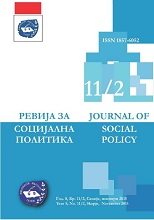Социјална инклузија на децата со интелектуална попреченост и децата со церебрална парализа
Social inclusion of children with intellectual disability and children with cerebral palsy
Author(s): Natasha Chichevska-Jovanova, Olivera Rašić-CanevskaSubject(s): Cognitive Psychology, Neuropsychology, Social development, Family and social welfare, Inclusive Education / Inclusion, Sociology of Education
Published by: Филозофскиот факултет во Скопје
Keywords: social inclusion; interaction; family; teachers; peers;
Summary/Abstract: The integrity of the personality of a person is the basis of his social status, and therefore without regard to the development of society, the individual leads a permanent battle for his affirmation and existence. The battle of socialization, the process of interaction in which the new member in the social community adopts knowledge, skills, habits, norms, values and other insights necessary for successful integration into the social group or the wider community is much more difficult and longer for persons of varying degrees and kind of disability. The aim of our research was to determine the mutual relations in the family as well as in the environment, with peers, teachers and some personal qualities such as: sociability, dominance and curiosity of children with intellectual disability and children with cerebral palsy. Using causal and descriptive analysis method, Rene Gill's testing technique and test for social and family relationships, sample data compiled of 12 children with cerebral palsy aged 5 to 20 years and 28 children with mild intolerant disability at the age of 7 to 20 years. The data were tabulated and statistically processed using the X-square test. The analysis of the results indicated that the two groups of respondents at a younger age were more attached to the mother, but in the later period the relationship of the boys with the father prevailed and the copying as a model, the other groups noted greater attachment to the teacher. The difference between the groups is noted in the distance and adequate social behavior, in boys with intellectual disability and girls with cerebral palsy there is greater distancing and adequate social behavior. We can conclude that the two groups are not fully adapted to the people and the surrounding environment.
Journal: Ревија за социјална политика
- Issue Year: 2015
- Issue No: 11/2
- Page Range: 509-522
- Page Count: 14
- Language: Macedonian

